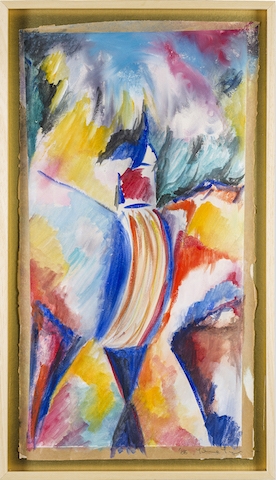Liliane Lijn is best known for largescale kinetic works – ranging from her ‘Poem Machines’, spinning cylindrical sculptures on which are written poetic fragments, to a series of public lightworks – made over a five-decade career. Her latest exhibition, however, presents not sculpture but 45 oil pastels and drawings on paper. These compositions, rich in palette, the marks gestural, swirling and groovy, date back to the 1980s or early 1990s and show a continuing pursuit of the American artist’s long-standing interests in cosmology and the cosmic, mythology and science. These were honed through early associations with both French Surrealism (from which she adopted a penchant for exploring the unconscious mind) and the Beat generation (her ‘Poem Machines’, shown in New York in 1962, won her William Burroughs as a fan).
The two-dimensional work on show here also retains a sense of movement: there is a frenzied feel to the scratchy oil-pastel markings of Firelight (1992), an explosion of red, orange and yellow paint that becomes denser as it ascends the sheet of paper. In Dance (1984) an amorphous blob drawn in orange and grey oil-pastel spreads across the sheet of the paper as a series of modular squiggles on a purple background. A spore of blue markings in the centre of the blob anchors this odd composition.
More focused are the works that acted as studies for installations. Woman of War was an ambitious 1986 sculptural work featuring a female figure. This steel and aluminium giantess also boasted flashing LEDs and lasers controlled by computer, and ‘sang’ (via a recording of Lijn’s voice) a song proclaiming the creature, seemingly a goddess of sorts, to be “an image of woman, an image of war”. Lijn has stated in interviews that around this time she sought to ‘elaborate a new image of the feminine’ through an exploration of both robotics and protofeminist mythology, and indeed this show takes a 1988 poem by the artist, ‘Bride’s Song’, printed as a stand-in for a press release, as its organising device. ‘Whirling wind woman’ goes one line; ‘I am the bride / Fragrant moon flower’, it continues.
In the sketches that preceded the sculpture, as well as paintings made after its realisation, we see Lijn experimenting with the form of her new woman, taking inspiration from both nature (the wasp or mothlike head of the figures in Woman of War and Woman of War with Koans, both 1987) and the built environment (the pylon-like figure in the ink and watercolour Study for Woman of War V, 1986). These visual experiments in hybrid womanhood, weighted in mystic philosophy and a hippy form of feminism, continue in works such as Her Monstrous Head (1989–94), Dark Angel (1991) and Lady of Light (1991), semi-abstract figures rendered in startling colours.
Lijn’s works of this period tapped into cybernetics and the cyborgian possibilities of burgeoning technology. Something was in the air: Donna Haraway published ‘A Cyborg Manifesto’ in 1984, a rejection of the boundaries between humans, nonhuman animals and machine. Over three decades later, these issues have become ever more urgent, and the questions Lijn was asking through these radical works even more pertinent.
Liliane Lijn: SHE at Rodeo, London 2–29 May
From the Summer 2019 issue of ArtReview
